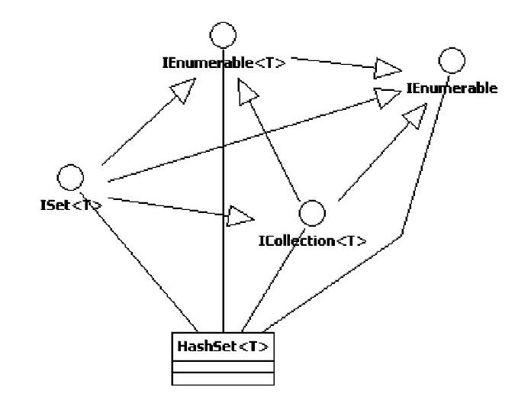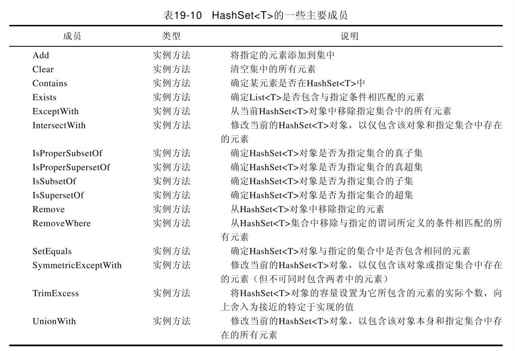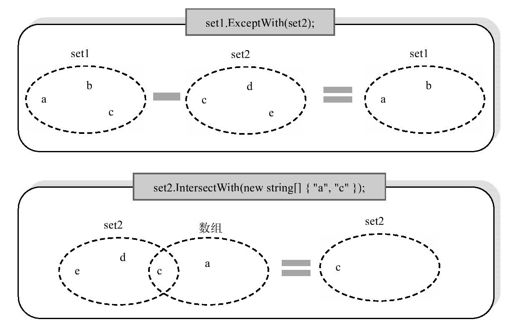19.2.8 HashSet<T>
HashSet<T>类主要是设计用来做高性能的集运算的,例如对两个集合求交集、并集、差集等。集合中包含一组不重复出现且无特定顺序的元素。
在.NET Framework 4.0中,BCL中新添加了ISet<T>接口,该接口提供了对集(Set)的抽象。HashSet<T>类实现了ISet<T>接口。该类的类图如图19-18所示。
HashSet<T>的一些特性如下:
❑HashSet<T>中的值不能重复且没有顺序;
❑HashSet<T>的容量会按需自动增加。
然后,我们了解一下HashSet<T>类的构造函数,并对每个构造函数进行说明,它共有5个构造函数。
❑public HashSet():使用集类型的默认相等比较器创建一个空的新实例;
❑public HashSet(IEnumerable<T>collection):使用集类型的默认相等比较器创建一个新实例,并把指定集合collection中的数据复制到集中;

图 19-18 HashSet<T>的类图
❑public HashSet(IEqualityComparer<T>comparer):使用指定的相等比较器comparer创建一个空的新实例;
❑public HashSet(IEnumerable<T>collection,IEqualityComparer<T>comparer):使用指定的相等比较器comparer创建一个新实例,并把指定集合collection中的数据复制到集合中;
❑protected HashSet(SerializationInfo info,StreamingContext context):使用序列化数据初始化HashSet<T>类的新实例。
因为HashSet<T>是专门设计用来做集合运算的,因而它提供的方法中有不少是和集合运算相关的,表19-10是它的一些常用方法介绍。

在代码清单19-13中,我们演示了使用3种不同的构造函数实例化HashSet<T>对象,尤其需要注意的是set3使用自定义的相等比较器。
代码清单19-13 HashSet<T>的代码示例
using System;
using System.Collections.Generic;
namespace ProgrammingCSharp4
{
class CollectionSample
{
public static void Main()
{
HashSet<string>set1=new HashSet<string>();
set1.Add("a");
set1.Add("b");
set1.Add("c");
HashSet<string>set2=new HashSet<string>(new string[]{"c","d","e"});
HashSet<string>set3=new HashSet<string>(new MyComparer<string>());
set3.Add("a");
set3.Add("c");
set3.Add("f");
PrintSetInfo(set1,"set1");
PrintSetInfo(set2,"set2");
PrintSetInfo(set3,"set3");
set1.ExceptWith(set2);
Console.WriteLine(“从set1集合中移除set2集合中包含的元素(差集)……”);
PrintSetInfo(set1,"set1");
set2.IntersectWith(new string[]{"a","c"});
Console.WriteLine(“set2集合仅包含数组(a、c)中也存在的元素(交集)……”);
PrintSetInfo(set2,"set2");
}
public class MyComparer<T>:EqualityComparer<T>
{
public override bool Equals(T x,T y)
{
if(x==null)
{
if(y==null)
{
return true;
}
else
{
return false;
}
}
else
{
if(y==null)
{
return false;
}
else
{
return x.Equals(y);
}
}
}
public override int GetHashCode(T obj)
{
return obj.GetHashCode();
}
}
private static void PrintSetInfo(HashSet<string>sampleList,string varName)
{
Console.Write("{0}:",varName);
foreach(string val in sampleList)
{
Console.Write("\t{0}",val);
}
Console.WriteLine();
Console.WriteLine("Count:{0}",sampleList.Count);
}
}
}
上述代码的运行结果为:
set1:a b c
Count:3
set2:c d e
Count:3
set3:a c f
Count:3
从set1集合中移除set2集合中包含的元素(差集)……
set1:a b
Count:2
set2集合仅包含数组(a、c)中也存在的元素(交集)……
set2:c
Count:1
请按任意键继续……
图19-19演示了上述代码中涉及集合运算的部分。

图 19-19 集合间的运算示意图
